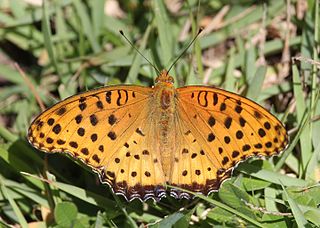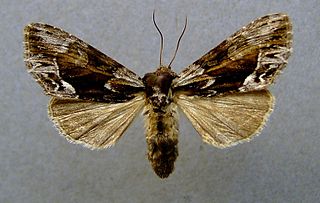
The Indian fritillary is a species of butterfly of the nymphalid or brush-footed family. It is usually found from south and southeast Asia to Australia.

Neptis jumbah, the chestnut-streaked sailer, is a species of nymphalid butterfly found in South Asia.

Euripus consimilis, the painted courtesan, is a species of nymphalid butterfly mostly found in India, Myanmar and Thailand.

Eupselia satrapella is a species of moth of the family Depressariidae. It is found in Australia, where it has been recorded from Queensland, New South Wales and the Australian Capital Territory.

Hyppa rectilinea, the Saxon, is a moth of the family Noctuidae. It is found in Europe, but mostly in northern and central Europe. In the south, it is found in scattered populations, mainly in mountainous areas. To the east, its range stretches through northern Asia and eastern Siberia, up to the Pacific Ocean and Japan.

Actinotia polyodon, the purple cloud, is a moth of the family Noctuidae. It is found in much of the Palearctic realm, from Europe to Russia and Japan.

Cosmopterix galapagosensis is a moth of the family Cosmopterigidae. It is known from the Galapagos Islands.

Lithophane furcifera, the conformist, is a moth of the family Noctuidae. The species was first described by Johann Siegfried Hufnagel in 1766. It is found from central Europe, east to the Black Sea region, the Caucasus and western Siberia. In the mountains, it is found up to elevations of 1,800 meters.
Sewa orbiferata is a moth in the family Drepanidae. It was described by Francis Walker in 1862. It is found in northern India, northern Myanmar, Malaysia, Borneo, Java and China.
Hypatima pilosella is a moth in the family Gelechiidae. It was described by Francis Walker in 1864. It is found on Borneo.
Ardozyga vacatella is a species of moth in the family Gelechiidae. It was described by Francis Walker in 1864. It is found in Australia, where it has been recorded from Queensland.
Charistica walkeri is a moth in the family Gelechiidae. It was described by Walsingham in 1911. It is found from Panama to Colombia.
Hapalonoma sublustricella is a moth in the family Gelechiidae. It was described by Francis Walker in 1864. It is found in Amazonas, Brazil.
Compsolechia scitella is a moth of the family Gelechiidae. It was described by Francis Walker in 1864. It is found in Amazonas in Brazil and in Peru.
Compsolechia suspectella is a moth of the family Gelechiidae. It was described by Francis Walker in 1864. It is found in Amazonas, Brazil.
Deltoplastis amicella is a moth in the family Lecithoceridae. It was described by Francis Walker in 1864. It is found in India (Assam), Myanmar and Sri Lanka.
Pantelamprus fimbripedana is a moth in the family Xyloryctidae. It was described by Francis Walker in 1863. It is found on Borneo.
Psittacastis superatella is a moth in the family Depressariidae. It was described by Francis Walker in 1864. It is found in Brazil (Amazonas) and Peru.
Hypertropha desumptana is a moth in the family Depressariidae. It was described by Francis Walker in 1863. It is found in Australia, where it has been recorded from Queensland.
Imma quadrivittana is a moth in the family Immidae. It was described by Francis Walker in 1863. It is found in Brazil.






